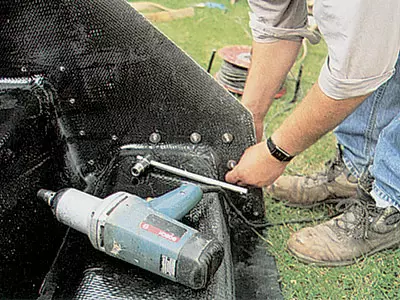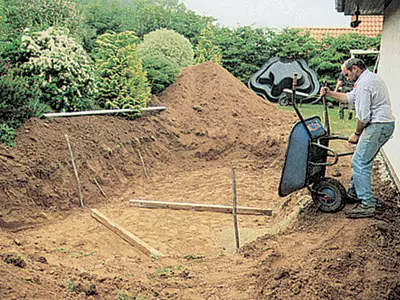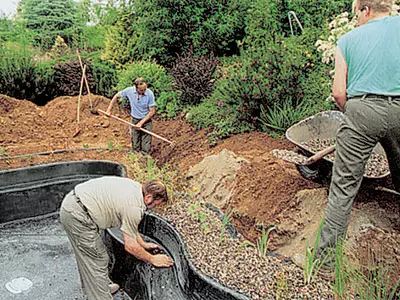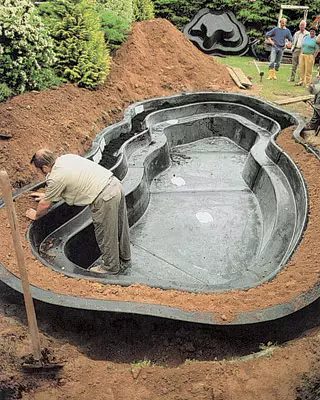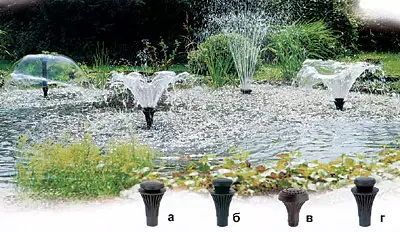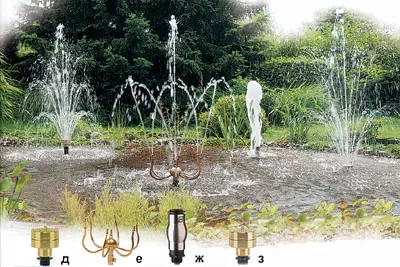
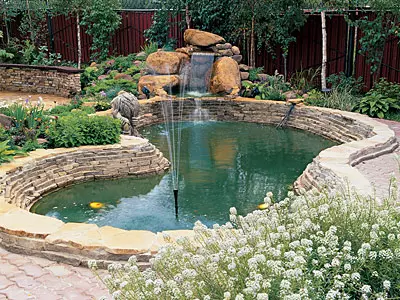
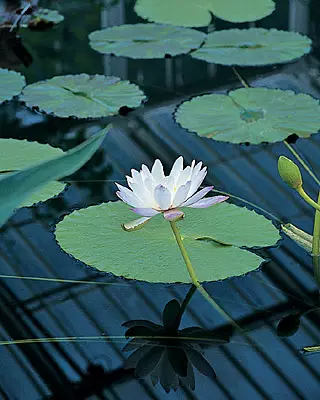
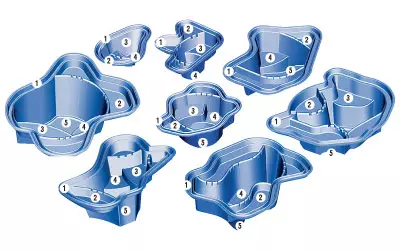
1, 2- for plants (10-25 cm),
3-shallow (35cm),
4- for the pump (60-80 cm),
5-deep-water (83-110 cm)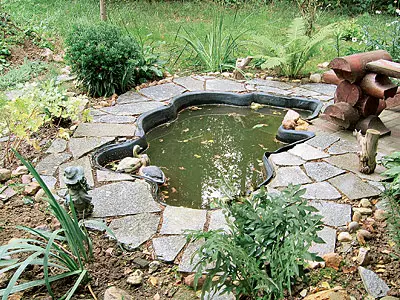

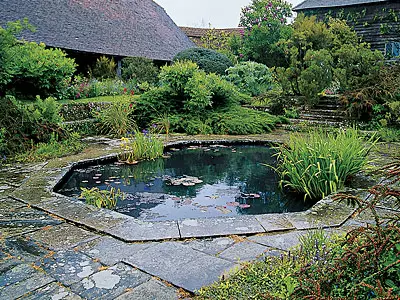
Flat stones can be used to decorate the coast. Using coconut mats with pockets in which can plant plants, even the sheer walls landslide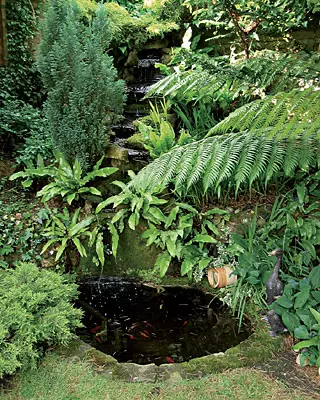
Type of running water creates a very attractive picture. Water supply to Cascade with a circulating pump contributes to aeration and water purification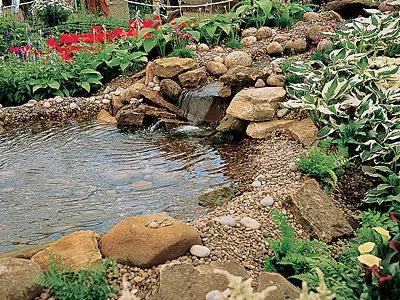
Pond on a clay castle. Such a reservoir is optimal for fish and aquatic plants.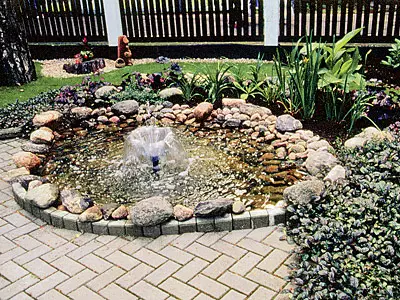
Any fountain is a closed hydrochlor: water is stored in a storage tank (pond-pond), drives with the pump and returns to the tank again.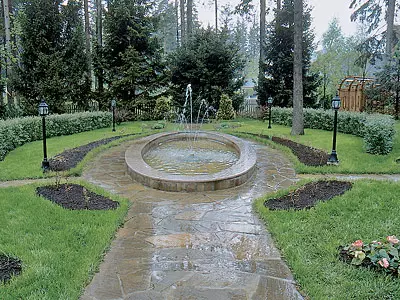
Concrete ponds are considered the most durable and reliable. The reinforced concrete design of the pond withstands the water pressure volume over 100m3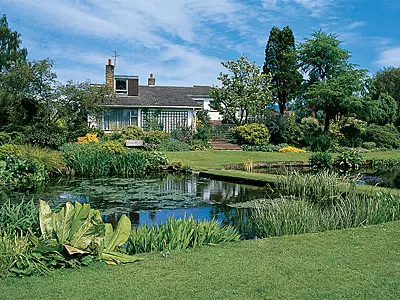
Plants are better placed in plastic baskets, which are installed on the bottom of the pond, and not to land directly into the soil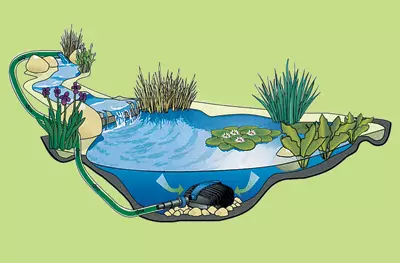
Submersible pumps for creating a waterfall place on the bottom of the reservoir on stones or special stands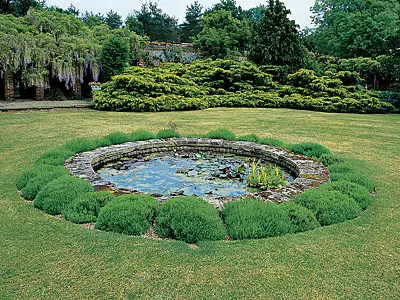
Last bar in the water branch device - the design of the coastal zone. In the case, the two most popular options for tile and green plant were combined.
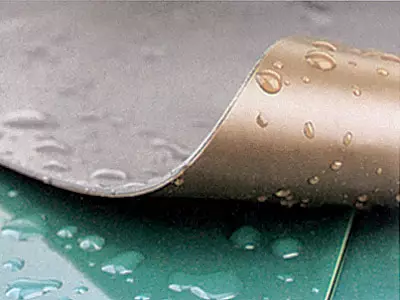
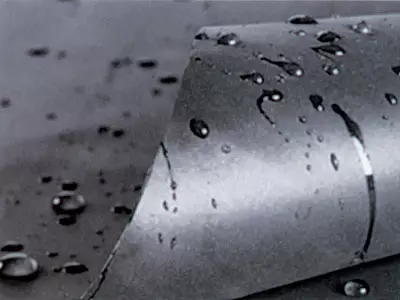
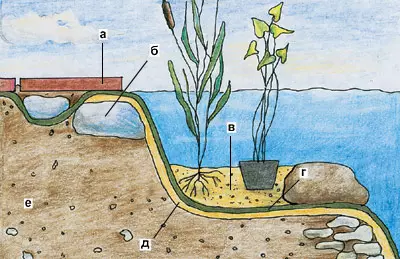
a-decorative framing;
B-concrete base;
in sand;
Mr. film;
d-geotextile or sand;
East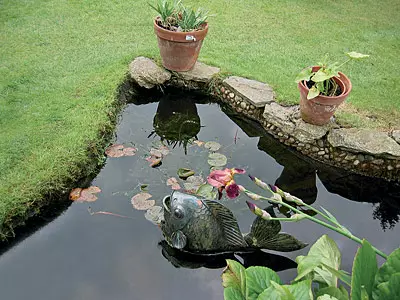
Sculpture fountains (in our case, fish) put, as a rule, near the shores of the pond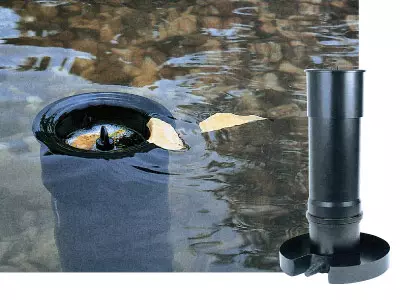
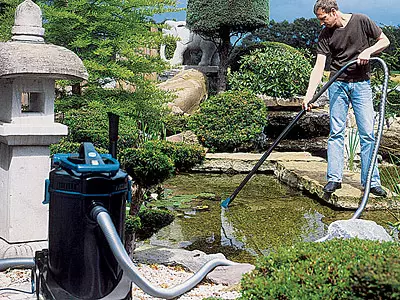
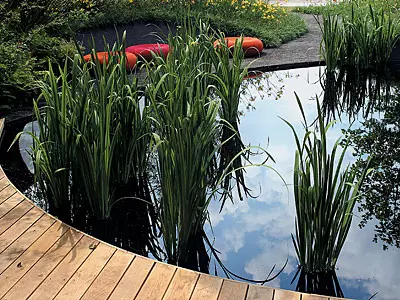
Not far from the shore at a depth of 5-15 cm, marsh plants are planted, the refisis, white dealer, Iris Idr.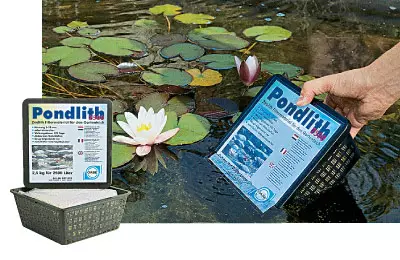
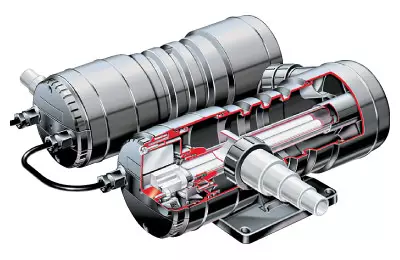
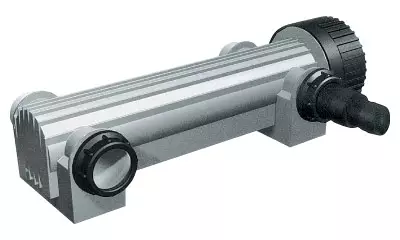
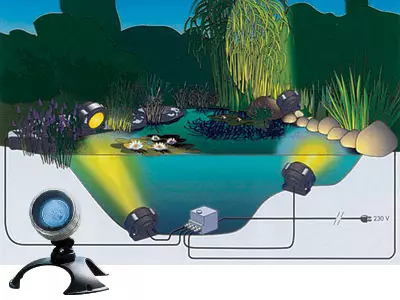
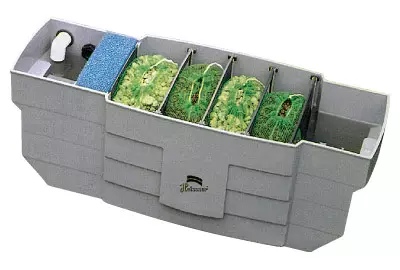
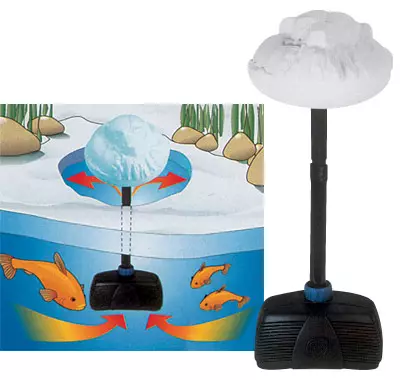
The editors thanks Osko, Petro-Domus, MC "Landshaft. Architecture. Design "," Harpak ", NP" Watering ", for help in the preparation of material
A man who dreams about an artificial reservoir on the country site is unlikely to explain all its charms. He himself knows them perfectly. The only question is that, materializing, dreams did not become a reason for disappointment. Agudoma Talk about water bodies in the garden will be in a purely practical
The subject of our interest is decorative pond, i.e. Artificially created by water, with specific vegetation, populated by aquatic animals. To simulate natural reservoirs, neither "raised" reservoirs, the walls of which are located above the level of land, nor regular, i.e. having a proper geometric shape. Avot so-called landscape ponds who are inherent in soft outlines and arbitrary shape - just what we need.
Here is such a width, here is the depth
Experts refer to ponds only those water bodies whose area ranges from 100m2 to several hectares. All that is less is called "puddles", where a full-fledged ecosystem is not capable of forming. Since most of us build on our sites, it is the "puddles", it should be remembered: to create at least a relative biological balance can only be in a pond with an area of at least 3.5m2. All other need constant filtering. It is very important to properly withstand the ratio of the area and depth: for a 3-5m2 pond, the depth should be 50-80cm, at 5-15m2-80-100 cm, from 15m2-1 more than 100 cm.
The reservoir of the depth of more than 80cm does not freeze to the bottom, but experts do not advise to make a pond too deep. Input with a depth of more than 1.5 m difficult to maintain cleanliness, plant plants, catch fish. In summer, the water in it is badly warming up, which means that aquatic plants develop more slowly. But freely feel microalgae, causing water flowering.
If you plan to use an artificial reservoir according to the full program, i.e. Located in it a water garden, breed fish, swim and even take a heated water for watering, be prepared for the fact that it is likely to turn into a technical tank. For a pond, it is better to choose one function. However, with a sufficiently large area, the reservoir can be tried to split into zones. For example, to arrange a fill with a water garden, and on the opposite side, a fairly deep bathing place with a convenient entrance. In order to live in the pond, the carps could live, along the bottom, a dance is digging with a depth of 1.2-1.5 m and 2-2.5 m wide. Avot to take from the pond water for watering is still not worth it. On the contrary, in the reservoir it is necessary to maintain a permanent level of water, bringing a hose to it and adjusting the uniform flow of fluid in the "dripping" mode. Inin forget to take care of the excess water excess, which can be formed as a result of heavy rains.
Deciding with the form and sizes of the pond, it is necessary to get acquainted with construction technologies.
Svetlana Amur, company "Harpak":
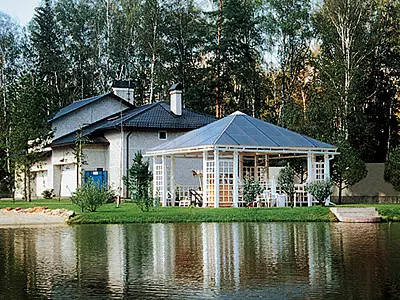
Usually, the pond is built closer to the house: the view from the windows becomes more attractive, and all the communications nearby. However, the shadow from the buildings and trees to the water is contraindicated, it should be covered with the sun six or eight hours a day. A close neighborhood with trees is better to avoid so that they do not damage the waterproofing with their roots, and in the autumn they did not fall asleep the pond leaves. A special danger to artificial reservoir are trees and shrubs, the leaves of which contain toxins. Pine needles and maple leaves stain water in a dark color and depress the aquatic plants. "
My dear, good, buy me "Kalo"
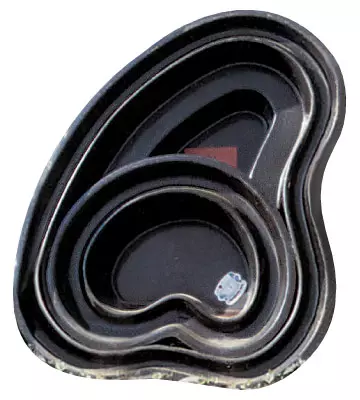
Ready "Caloshi" made of polyethylene or fiberglass - the easiest and fastest way to arrange a small pond at the cottage. Polyethylene forms are produced by a volume of 130-900l. The service life is more than ten years. But if when transporting or installing the wall "Calosh" was damaged, it would not be possible to secure the crack to securely. The Russian market mainly represented ready-made polyethylene forms of domestic production (series "Relief", "Seliger", "Peter" IDR.). They are somewhat cheaper than the products of manufacturers such as OASE or Heissner, but practically do not inferior to it, since they are made according to corporate samples and from the same material. The price of such ponds varies from $ 28 to $ 180, depending on the volume.
"Kaloshi" from fiberglass will serve up to 30 years. They are subject to repair. It is quite possible to create a pond of up to 1200l. Manufacturers produce forms and much more (up to 4000l), but specialists are not recommended to apply them in our climatic conditions, it can crack in frosty winter, especially if it is incorrectly installed. Fiberglass "Kalosh" produce German companies OASE and Heissner, Dutch company Ubbink. It is quite natural that such a pond is more expensive than polyethylene: $ 180-290 depending on the volume.
The construction of such a reservoir takes only a few hours. "Kalosa" put on the ground and marked its contour on the basis. Then they choose the land with a margin at the edges, flush the bottom and fall asleep with sand. On the sandy pillow strictly horizontally install the finished shape. The crisp between her walls and pitted sand. If the container is made of rubber or thin plastic, it is poured on a third with water so that the ground does not give the walls. Then the sand falls asleep, the trambet and so repeat several times.
|
| Ready-made fiberglass forms are the fastest way to arrange a pond. Some companies produce "Kaloshi" unassembled, so before starting work, all parts are connected to each other (1). After that, its contour is placed on the surface, chose the bottom, equal and fall asleep with sand (2). Next, the shape is installed in the gap between the walls and the pitted sand and the trambet (3, 4) fall asleep |
|
|
Hold the pond "On the clay castle"
Imitating a natural pond, I want the waterproofing to be akin to natural. Make it troublesome, but it is not difficult and inexpensive. The material is the usual fatty clay taken from the lower layers of the waterproof. Holding a few days in the water, it is kneaded to the state of a soft dough, and then the layer in 15cm is applied to the walls and the bottom of the pit. Carefully tamped the first layer and giving it to dry, the resulting gaps are watched and apply the second layer, smoothed and compacted. The upper clay layer will sees a thin layer of gravel, which poured fine crushed stone or sand (5-7cm). The shores of such a pond do not cooler 20-25. The covering layer of clay should rise above the water level of at least 15 cm. Since clay material is slippery, the edges of the reservoir are usually strengthened with a flat stone. Such waterproofing is not terrible (ground) water, they are simply filtered through clay. Over time, the clay coating will only last, but it can significantly suffer from plant roots and rodents.Armor strong, but ...
The material that is easily opposed to the like, as well as many other destructive effects, is well known is concrete, widely used in the construction of water bodies. The technology of working with concrete is different, depending on the size of the pond, the characteristics of the site and the materials used: reinforcement, waterproofing, etc. But in any case, they are quite complex and multi-step. First, naturally, the rotting, the walls and the bottom of which are thoroughly tamped, and then lined with geotextiles and fall asleep with rubble with sand. Such a backstage not only "holds" concrete, but also performs the function of the drainage for groundwater. The backfill is covered with a waterproofing material and a reinforcing mesh, which causes the first layer of concrete, and after a while - the second one, the surface of which is thoroughly aligned and coated with a layer of waterproofing material, such as liquid glass. The problem of waterproofing can also be solved with a film or plastic coating.
Choosing a "concrete" option, you need to take into account that in this case the construction will take quite a lot of time: it will take it from two to three to 15 days. The process can be accelerated using, for example, concrete based on the straining cements of the NC series. The solution is solid from it quickly, and the products are obtained very durable and absolutely waterproof, which frees from the need to make additional waterproofing. Increased water and frost resistance of concrete removes the main challenge of the bowl under the influence of low temperatures.
Note that the "concrete" pond is not cheap. The construction of the foundation for a water branch volume of 100m3 will cost about $ 2000, the construction of the bowl - $ 300-350 per 1m3, waterproofing with special mixtures - $ 20-35 per 1m2 (film- $ 45-60, plastic coating, $ 90). Significant expenses will require the engineering and technical equipment of the reservoir, decorative design, etc. At the final price, the features of your plot will also affect the final price, and, of course, the status of the company you trust (large companies are accounted for about 80% of the cost of construction). In love, the preference should be given to professionals who have extensive experience with such objects, since serious errors are allowed in this case very often, and their elimination costs them in a round sum, and it is impossible at all. Remove from the site of the fruits of the effort of Mount-Builders - a giant problem.
Pack pond in the film
Perhaps the most common construction technology of ponds - using flexible waterproofing, in particular, films. More recently, this material was considered unreliable, requiring special care and frequent replacement. The situation in the market of new types of film has changed dramatically. Today, the consumer offers three main types of flexible waterproofing: based on polyethylene, polyvinyl chloride (PVC) and Butyl rubber (EPDM). The best of them are not afraid of frosts, resistant to UV radiation, absolutely non-toxic and strong enough. The most durable and reliable is considered waterproofing from Butyl rubber. Thus, the service life of the EPDM film Canadian production exceeds 70 years, and its thickness (1.15mm) is ideal for the construction of sufficiently large ponds. All records of longevity beats the waterproofing geomembrane BlackLine TFS Danish company MONARFLEX, which exceeds 80 years. The EPDM will always be guaranteed for 30 years. PVC film service life is significantly less than 10-15 years. Prices for Butyl rubber film at such a manufacturer, like Firestone (USA), fluctuate from $ 65 for 1 p. m with a width of 6.1 m and to $ 130 with a width of 12.2 m. Prices for domestic analogues are about a third below. PVC film from OASE and Hobbipul (Germany) will cost $ 14 to $ 56 for 1 p. M depending on its width and thickness.
For water bodies, built with flexible waterproofing, there are practically no restrictions on form and sizes due to modern gluing technologies and welding seams. The most reliable experts consider the method of hot vulcanization using special mastic. In the case of seam, according to them, it turns out the stronger the film itself. To roughly define the amount of film for the pond, the following formulas can be used:
Length piece = Pond length + two depths + 0.6 m (on fixing the film at the edges);
Slash width = Pond width + two depths + 0.6m.
Build a pond using a film, in principle, is not difficult. For this, the bottom of the pit is thoroughly spread, the trambet, fall asleep with a layer of wet sand with a thickness of 5-10 cm and stood with geotextiles. This durable and elastic nonwoven material reinforces the slopes, and also protects the film from germination of roots and other mechanical damage. Calculating the size of the film coating, keep in mind that in length and width it should be 2-2.5 times greater than the depth of the pond. The pit is covered with a film, giving the stones of its edges, which go to the shore by about 50cm, and poured with water, which saming the coating itself. After filling, the water edge is cut to 15 cm. Then it is stretched and attached to the ground. The edge of the reservoir is brushed with tiles or natural stone stacked on a lime solution, completely closing the film. For these purposes, gravel dumps are suitable.
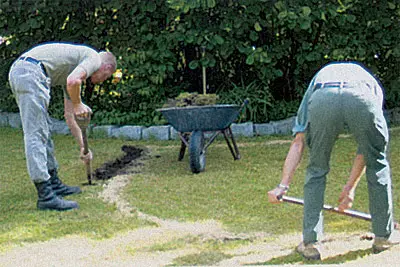
| 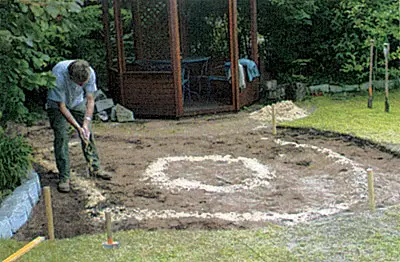
| 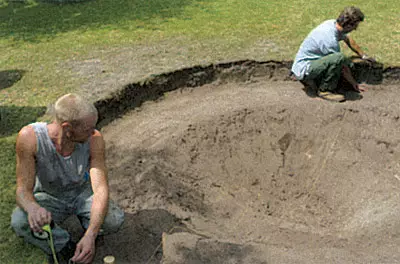
|
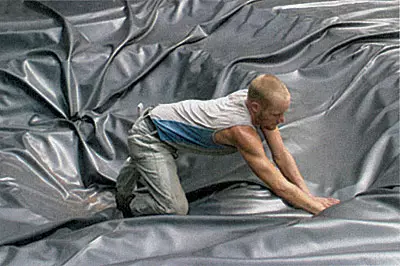
| 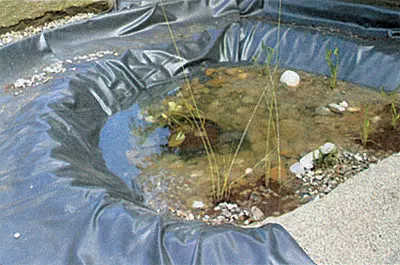
| 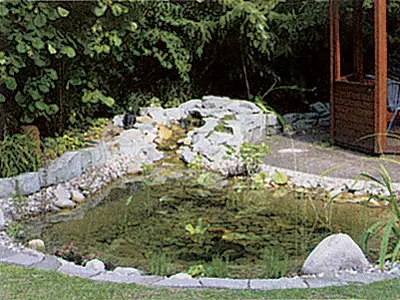
|
However, the pond wall tightened by the film, unfortunately, do not fit with the appearance of a natural reservoir, even if it is almost not visible through the water. The same, causing a water garden or bathing, the film can be easily damaged. Special mats for slopes made from synthetic or natural materials, such as coconut fibers, will solve this problem (the cost of the latest one). Their loose structure looks very natural and is an excellent shock absorber. At the same way, one of these mats will be a wonderful track for entering the reservoir.
Prices for the construction of film reservoirs depend on many factors and therefore fluctuate in significant limits ranging from $ 100 for 1m2. Professionals who build you a pond in all the rules, including engineering and geological research, drainage system, engineering communications and decorative design, 250m2 with a depth of 2.5m will take no less than $ 25,000.
Ecosystem named puddle
Just a few days passed, as you poured your pond with clean artesian water, and there were already the first inhabitants of Daphnia and Cyclops mini-ramps. These barely noticeable goat and microalgae, which they feed on, in your pond literally inflated the wind. They became the first brick in building an ecosystem just born reservoir. Everything else you have to lay your own hands.The most important element of such an ecosystem, of course, are plants. Water garden start to form with approach to the pond. Not far from the water, it is better to grow moisturely busy perennial plants: whipping, crawl, peppermint, Irises, Bolotnaya, Primulus, Lily of the Lily, Karpolistra's bell, Oakravny's bell, Badan, Aquail, Hosts, Lilyniki, and PRD. The marsh plants are usually planted, whose roots are under water, and stems, leaves and flowers - upstairs. Such a border will help to form a marsh fern, rogoz, reed, whitefly, Iris Airovoid, water pine, Derbennik, Irovel, Pontederia IDR. The pond mirror will decorate the plants, the leaves and flowers of which float on the surface of the water: Susak is an umbrella, a slim, a chastush of the plantain, a wallers of a palate card. But the main among them is undoubtedly nitness (water lily, water lily). It is she who creates amazing blooming islands on the surface of the water, the diameter of which reaches one and a half meters. Naturally, no exotic, and winter-hard-resistant species that are capable of wintering with a depth of 50-80cm will be suitable for our climate. The floating leaves of the nymph are not only aesthetic, but also an ecological function. Protecting water from sunlight and overheating, they prevent the growth of weed algae. So that the water in the pond remained transparent, the leaves should cover up to half of its surface. Do not forget about the so-called oxygenators. These inconspicuous plants are entirely under water enriched with oxygen, absorb minerals and carbon dioxide, making meals with microalgae.
Water plants can be planted directly into the ground, but the optimal option is container landing. It is best to use mesh baskets, through the cells of which will freely heat the roots. Container landings facilitate care of both plants and for the pond themselves. Another important advantage is the opportunity to vary the color and volumetric plant compositions, taking into account the life cycle of certain plants, as well as your mood. Especially interesting in this plan in largest plants. This it is possible to make a real muddy to turn the revenue to the beautiful water garden.
What kind of pond will cost without floating, crawling and jumping inhabitants? We put the omnipresent frogs will find your reservoir. Avot of water snails or pondovikov can be brought from the nearest river. Just a few individuals will soon be broken and will diligently clean your pond. Frogs, karasi and rhotans will open the hunt for mosquitoes and their larvae. Decorative fish will become a real decoration of the reservoir and the most interesting object for observations. Goldfish feel perfectly in shallow water (45-60cm), however, for the winter they will have to move to aquarium. Fish Koi and colored carps prefer to live deep (1.2-1.5 m), where they completely concern. Avot Rotans can exist at any depth and not at all affect, even if the pond is freezing to the bottom. The main thing is not to turn the decorative pond in the curtain for growing fish. For example, in a reservoir of 25m3, experts advise not more than 10-12 adult carps. ONE In your "ecosystem" peace and peace come together.
My, clean, vacuum ...
A stable, self-regulating ecosystem is not easy to create in an artificial reservoir. But if you managed it, it will be quite easy to care for it. The summer season's comment will have to work in the main saccmoman, collecting leaves from the surface of water, chew, the fluff, removing the tangles of nital algae, etc., do such a cleaning quite often, because if you don't remove the garbage, then after two or three days it will fall on the bottom and Start rot. Skimmer will greatly facilitate this procedure from a plastic basket, which drifts in a pond just below the water surface. We constantly suck the pump in it constantly sucking water and floating garbage. You will also remain clean the basket as it fills it.
About once instez, specialists advise to clean the bottom of the reservoir. Ultimate artificial coating for removal from walls and bottom, weeding algae and dead plants, you can use the "underwater vacuum cleaner", i.e. Electronasus with suction nozzle. HEISSNER, HOZELOCK and OASE vacuum cleaners are most popular. The pondovac of the company OASE The length of the suction hose is 5-8m, which allows to clean the pond with a diameter of 10-16m. Ilvesy through an adjustable nozzle (2-10mm) in a 30-liter container, after filling which the vacuum cleaner is turned off. Such a "car" will cost $ 235.
Do not be afraid if your pond "will bloom" with the onset of heat, i.e. Water in it will green as a result of active growth of microalgae. In principle, such a problem occurs every spring and does not require any emergency measures. If the pond is healthy, after a while it will work the mechanism of self-cleaning. Specialists warn: it's not worth replacing the flowering water. By this, you only improve the nutrient medium for algae, and soon the pond seasones the former. The same replacement of water will completely destroy the established biological balance.
If the reservoir is too small to deal with its own problems, or the current ecosystem is derived from equilibrium, it is necessary to help more radically using all types of cleaning: mechanical, biological, UV radiation, and maybe chemical. The mechanical filter in which water injected by the pump is driven through a container with a porous material, will relieve the pond from weeding algae and garbage. When the filter clogs, the container is purified and fill in a new filter material. Filter performance varies in a wide range. Therefore, your choice will depend on the volume of the pond, taking into account the fact that in small water bodies (about 10m3), water should pass through the filter for five to six times. An example of such a device for mechanical cleaning DELTA. Its cost is $ 382-2055 depending on performance.
Biological cleaning filters decompose proteins, fats and carbohydrates in water, running it through a container with porous material, inhabited aerobic and anaerobic bacteria. Such, for example, Bioforce filters ($ 73-580) and EcoCel ($ 57-102) Hozelock, as well as Biotec ($ 850-2215) and Pondlith ($ 47) from OASE.
Ultraviolet filters are successfully fighting with microalgae, affecting them UV radiation, due to which the water is covered. The device is a housing, inside of which the lamp is located. The design is necessarily complemented by a mechanism that prevents the overgrowing of the lamp by algae. On the Russian market, the most famous UV filters Bitron production OASE (from $ 160), Aqua UV from Heissner ($ 185-275), UVC Vorton from Hozelock ($ 103-264).
"Atoll" will take care of the purity of the pond
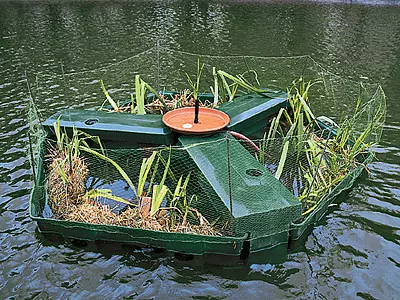
One setting "Atoll" will provide the purity of the reservoir with an area of up to one hectare. For the treatment of launched ponds, the same area will need four to seven installations, usually with their help they are restored over the summer. But if the disease has come too far, the process can stretch for two to three seasons. Upon completion of treatment, the installation is better to leave in the pond as a prophylactic agent that will work regularly at least ten years.
The owners of the reservoirs, probably, it will be interesting to find out that the setting "Atoll" is easy to turn into a floating flower bed - throughout the platform circle, a special step for containers with blooming moisture plants is made, and spacious caspo is fixed to the side. Wtach flowerbed perfectly fit into the juicy green "workers" plants that are planted below on the platform. Av Center it can be placed with a backlit fountain.
The cost of one installation "Atoll" is $ 3,000, its service costs $ 500 per season.
There is no limit to perfection
Clean, healthy, decorated with plants with water, is beautiful without any additional decor. Ipriri correct care will be good from year to year. But beauty never happens too much. First of all, the pond needs a decent framing, which should be taken by even its construction. Most often, natural stone or tile is used for the border or walking along the shore of the track. Begging is better to lay on a concrete base. The edges of the tile must hang over the water about 3 cm. And, of course, the material should not be slippery. Do not forget to give the track a small bias to the side opposite to the pond, then dirty water will not be drained into it. On the shore of the reservoir, the rocarium looks great, for the device of which the fertile soil layer is usually used, taken upon digging of the pit, in combination with sandstone, which accumulates solar heat and does not poison water with lime.
Fashionable now detailed bridges, which in addition to their direct function can serve as an excellent species platform. For our gardens, bridges from metal, stone or wood of natural texture and color are best suited. It looks pleasant to the bridge, as if continuing the garden by Step by Step. Miracle to build, thanks to which, on the water, the ideal of "Aki Tool" can be from the usual paving slabs.
Of all the decor elements, no one compares with fountains that make water truly alive. To build a water fireworks in the pond today, Grundfos, OASE, WILO (Germany) and others offer for this everything you need, including multiple power pumps, designed for a long continuous work, as well as a huge range of fountain nozzles. Each of them creates its own, unique water picture. The height of the ejected jets reaches 5m or more. However, experts advise them to proportionate them with the sizes of the reservoir: the diameter of the pond should be at least twice the height of the water column. The same constant rain and troubled water are unlikely to like plants and fish. Avot is a low boiling key will provide additional aeration, which will benefit all the living.
|
|
The shape of the jet and the direction of movement of the floating fountain depends on the selected nozzle: A- bell; b, g-bowl; in, d, z- volcano; e - sprayer-turntable; Foam jet. A falling jet must be at some distance from floating plants, in order not to damage them
Frequently, the fountains are very popular, the jets of which are directed not up, and down. Often they are drawn up as a natural spring. The source of water can also serve a variety of decorative figures, jugs, etc. Imitation of waterfalls, water curtains and walls are also the options for fountains.
In short, fantasy designers inexhaustible. Especially love to experiment with the game of water, light and colors. For external illumination of the reservoir, special lamps are used with directional or diffused light that can be equipped with color filters. They are mounted on racks directly in water or placed next to the pond. Since electrical equipment in direct contact with water is an increased danger, no self-identity is unacceptable here. Understanding the installation of a system of underwater lighting can only be professionals. Yes, and most effectively organize highlighting for only experienced designers.

